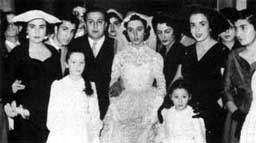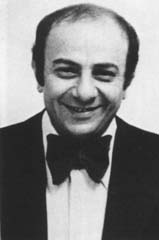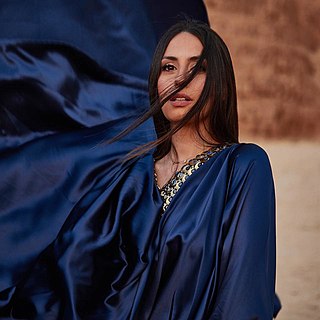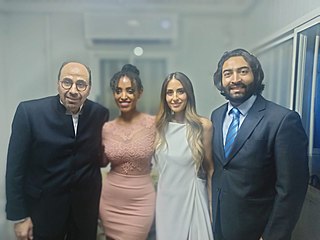Related Research Articles
The music of Lebanon has a long history. Beirut, the capital city of Lebanon, has long been known, especially in a period immediately following World War II, for its art and intellectualism. Several singers emerged in this period, among the most famous Fairuz, Sabah, Wadih El Safi, Nasri Shamseddine, Melhem Barakat, Majida El Roumi, Ahmad Kaabour, Marcel Khalife, and Ziad Rahbani, who—in addition to being an engaged singer-songwriter and music composer—was also a popular playwright. Lydia Canaan was hailed by the media as the first rock star of the Middle East.

Nouhad Wadie Haddad, known as Fairuz, is a Lebanese singer. She is widely considered an iconic vocalist and one of the most celebrated singers in the history of the Arab world. She is popularly known as "The Bird of The East", "The Cedar of Lebanon", "The Moon's Neighbor", and "The Voice of Lebanon", among others.

The culture of Lebanon and the Lebanese people emerged from Phoenicia and through various civilizations over thousands of years. It was home to the Phoenicians and was subsequently conquered and occupied by the Assyrians, the Greeks, the Romans, the Persians, the Arabs, the Crusaders, the Ottomans and the French. This variety is reflected in Lebanon's diverse population, composed of different religious groups, and features in the country's festivals, literature, artifacts, cuisine and architecture of Lebanon. Despite colonization by different entities genetic testing has revealed that 89% of Lebanese people today descend from the Phoenicians. Regardless of religion or colonization which were layers of paint on top.

Ziad Rahbani is a Lebanese composer, pianist, playwright, and political commentator. He is the son of Fairouz, one of Lebanon and the Arab world's most famous singers, and Assi Rahbani, one of the founders of modern Arabic music.

Assi Rahbani was a Lebanese composer, musician, and producer. He was part of the Rahbani Brothers, with his brother Mansour Rahbani. He married Lebanese singer Nouhad Haddad, more famous by her stage name, Fairuz. Their son Ziad Rahbani is also a very successful artist in music, theatre, and an influential political activist.

The Rahbani brothers, Assi Rahbani and Mansour Rahbani were Lebanese sibling musicians, composers, songwriters, authors, and playwrights/dramatists, best known for their work with the singer Fairuz, Assi's wife. Their younger brother Elias Rahbani was also a famous lyricist and composer.

The cinema of Lebanon, according to film critic and historian Roy Armes, is the only other cinema in the Arabic-speaking region, beside Egypt's, that could amount to a national cinema. Cinema in Lebanon has been in existence since the 1920s, and the country has produced more than 500 films.
Omar Naim is a Lebanese film director and screenwriter best known for writing and directing the 2004 film The Final Cut.

Hamra Street or Rue Hamra is one of the main streets of the city of Beirut, Lebanon, and one of the main economic and diplomatic hubs of Beirut. It is located in the neighborhood of the same name, Hamra. Its technical name is Rue 31. Due to the numerous sidewalk cafes and theatres, Hamra Street was the centre of intellectual activity in Beirut during the 1960s and 1970s. Before 1975, Hamra Street and the surrounding district was known as Beirut's trendiest, though in the post-war period it has arguably been eclipsed by Rue Monot in Ashrafieh, Rue Gouraud in Gemmayzeh, Rue Verdun, and downtown area. In the mid 1990s, the Municipality of Beirut gave a facelift to the street to reattract tourists all year round. Hamra Street was known as Beirut's Champs Elysées, as it was frequented by tourists all year round.
Jean G. Daoud is the founder of the "Holistic Method" in actor training and "Play art and Creativity Therapy". he is a philosopher, poet, playwright, professor and researcher in acting, stage production and art therapy. He holds a degree in Cinema and Theatre Studies from University of Paris VIII, and is Professor of Drama and directing and Department Head of Theatre at the Lebanese University. He is an expert in "Creative Pedagogy" and Therapy through actor training. He is the founder of the Laboratoire de dramaturgie, d'actorat et de textes. He is the Secretary-general of "Beirut's Congress of Theater".
The 2008 Arab Capital of Culture was chosen to be Damascus, Syria. The Arab Capital of Culture is an initiative undertaken by UNESCO, under the Cultural Capitals Program, to promote and celebrate Arab culture and encourage cooperation in the Arab region. The preparation for the festivity began in February 2007 with the establishing of the Administrative Committee for “Damascus Arab Capital of Culture" by a presidential decree.
Pascale Etienne Sakr is a Lebanese singer. She was born in Zahlé, Lebanon to Maronite parents from Ain Ebel, south of Lebanon. She performs a leading character in many musicals. She graduated from law school in 1987.
Salwa Al Katrib was a Lebanese singer and stage actress best known for her roles in Emerald Princess and Mountain Girl. She was the wife of Nahi Lahoud and the mother of aspiring Lebanese actress and singer Aline Lahoud. She enjoyed most of her fame in the theatrical circle in Lebanon and the Arab world between 1974 and 2005. She died of cerebral hemorrhage in 2009.

Hiba Michel Tawaji is a Lebanese singer, actress, and director. Since 2008, she has established herself in the Lebanese and Arab music scene with her 4-octave vocal range.

Nazl el-Sourour is a musical play created by Lebanese playwright and composer Ziad Rahbani.

Oussama Al Rahbani is a Lebanese musician and composer. He is the son of the Lebanese composer, musician, and poet, Mansour Rahbani.
Roger Assaf is a Lebanese playwright, director and actor.

Lina Khoury, born April 27, 1976, is a Lebanese theatre director, writer, producer, and educator. She is known for tackling taboo subjects and raising controversial questions in her plays.
Nidal Al Achkar is a Lebanese actress and founder/director of the Al-Madina Theatre in Beirut. In April 2024, news reports named her as the instigator behind a campaign that resulted in the ban of a play that was to be presented at the Monnot Theatre, within the campus of Beirut's Saint Joseph University.

Takla Chamoun Farjallah is a Lebanese actress, drama instructor, producer, and the co-founder and CEO of the Lebanese Film Academy. Chamoun is highly regarded in the Middle East and the Arab World for her acting and her ability to mold into a character.
References
- ↑ Stone, Christopher Reed. Popular Culture and Nationalism in Lebanon: the Fairouz and Rahbani Nation, page 50
- ↑ Kassir, Samir (2013). Being Arab. Verso. ISBN 978-1-84467-280-6. OCLC 866820842.
- ↑ Badawī, Muḥammad Muṣṭafá. Modern Arabic Literature
- ↑ Abisaab, Rula Jurdi. Depicting Relations: Iran and Lebanon in the Last 500 Years, page 11
- ↑ Johnson, Michael. All Honorable Men: The Social Origins of War in Lebanon, page
- 1 2 3 Khalaf, Samir. Civil and Uncivil Violence in Lebanon, page192
- ↑ Long, Charles. Tawfiq Al Hakim, Playwright of Egypt, page 235
- 1 2 3 4 Kassir, Debevoise, and Fisk. Beirut, page 216 ISBN 9780520256682
- 1 2 3 Allen, Roger M. A. An Introduction to Arabic Literature, page 208
- ↑ Khalaf and ShukryKhoury. Recovering Beirut: Urban Design and Post-war Reconstruction, page 248
- 1 2 3 4 Hochman, Stanley McGraw-Hill Encyclopedia of World Drama: an International Reference, page 182
- ↑ )Migliorino, Nicola. Reconstructing Armenia in Lebanon and Syria: Ethno-Cultural Diversity, page 124
- ↑ Stone, Christopher. Popular Culture and Nationalism in Lebanon: The Fairouz and Rahbani Nation, page 68
- ↑ "Lebanon comes to London : Time Out" (PDF). Caracalladance.com. Retrieved 2013-10-31.
- 1 2 Zaccak, Hady. Le Cinéma Libanais
- ↑ Carter, Dunston, and Thomas. Syria and Lebanon, page 257
- ↑ "Mansour Rahbani: Lebanese playwright and composer," The Times, 22 January 2009
- ↑ "The Al Madina Theatre". Almadinetheatre.com. Retrieved 2013-10-31.
- 1 2 "Culture :: Performance :: Maqamat Dance Theater features local, international artists". The Daily Star. 2011-10-08. Retrieved 2012-02-16.
- ↑ "Play Challenges Lebanese to Face Past, Present". NPR. 2007-10-06. Retrieved 2012-02-11.
- 1 2 Writer, Feature (2010-03-01). ""12 Angry Lebanese": interview with Zeina Daccache". ArabComment. Retrieved 2012-02-11.
- ↑ "Le Grand Theatre de Beyrouth « The Lebanese Inner Circle : Blog". Theinnercircle.wordpress.com. Retrieved 2012-02-11.
- ↑ "Théâtre de Beyrouth in Beirut, Lebanon". Lonely Planet. Retrieved 2012-02-11.
- 1 2 Carter, Dunston, and Thomas. Syria and Lebanon, page 289
- ↑ Time Out Beirut. "Monot Theatre » Arts & Culture". Time Out Beirut. Retrieved 2012-02-11.
- ↑ "Culture :: Performance :: Dance continues 250 years of cultural trade". The Daily Star. 2011-10-14. Retrieved 2012-02-16.
- ↑ "ITI adopts new strategy | Priyo News". News.priyo.com. Retrieved 2012-02-11.